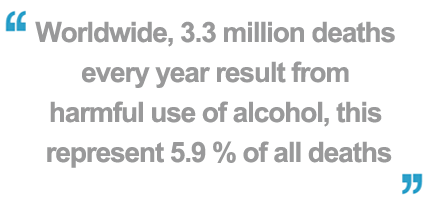 Harmful use of alcohol causes detrimental health and social consequences for the drinker, the people around the drinker and society at large. An excessive use of alcohol is associated with increased risk of adverse health outcomes.
Harmful use of alcohol causes detrimental health and social consequences for the drinker, the people around the drinker and society at large. An excessive use of alcohol is associated with increased risk of adverse health outcomes.
The harmful use of alcohol is one of the world’s leading risk factors for illness, disability and death. It is a primary cause of more than 200 diseases and injuries and globally results in approximately 3.3 million deaths each year, greater than HIV/AIDS, violence or tuberculosis.
In addition, 4.8% of the global burden of disease and injury is attributable to alcohol. Globally, alcohol consumption is estimated to cause more than 10% of the burden of noncommunicable diseases, including cirrhosis of the liver, pancreatitis, cancers (oral and pharynx, larynx, oesophagus, liver, colorectal), haemorrhagic stroke and hypertension.
In addition to the chronic diseases that may develop in those who drink large amounts of alcohol over a number of years, alcohol use is also associated with an increased risk of acute health conditions, such as injuries, including from traffic accidents, mental disorders, depression or memory loss.
Regional burden
According to the "Global report on alcohol and health 2014" alcohol consumption in the Eastern Mediterranean Region is low. It is estimated to be almost 10 times lower than global consumption i.e. 0.7 litres of pure alcohol per capita per year compared to 6.2 litres.
Overall, life-time abstainers i.e. those who have never had a drink are high – around 90% regionally compared to 48% globally. However, among the population consuming alcohol, hazardous patterns of drinking are noted with heavy episodic drinking – known to be more harmful than regular light-to-moderate drinking. Also, recent data indicate that alcohol consumption is on the rise among adolescents and young adults in the Region.
Global strategy
 In 2010, the Sixty-third session of the World Health Assembly adopted resolution WHA63.13 which endorsed a global strategy to confront the harmful use of alcohol. Every year, the harmful use of alcohol kills 2.5 million people, including 320 000 young people between 15 and 29 years of age. It is the third leading risk factor for poor health globally, and responsible for almost 4% of all deaths in the world, according to 2004 estimates.
In 2010, the Sixty-third session of the World Health Assembly adopted resolution WHA63.13 which endorsed a global strategy to confront the harmful use of alcohol. Every year, the harmful use of alcohol kills 2.5 million people, including 320 000 young people between 15 and 29 years of age. It is the third leading risk factor for poor health globally, and responsible for almost 4% of all deaths in the world, according to 2004 estimates.
The vision of this strategy is to improve the health and social outcomes of individuals, families and communities, considerably reducing disease and death due to harmful use of alcohol and their ensuing social consequences. Its implementation requires active collaboration with Member States, with appropriate engagement of international development partners, civil society, the private sector, as well as public health and research institutions.
Global strategy to reduce the harmful use of alcohol








